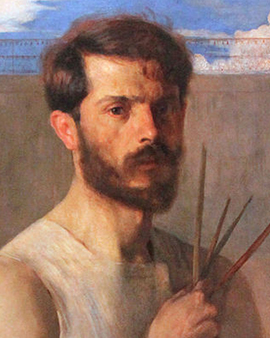While Argentina or Uruguay are still characterized by Italian immigrants, in Brazil they are rather a minority among many. And yet the Sugarloaf Mountain boot has also produced important contemporaries, such as the painter Eliseu Visconti.
Visconti was born as an Italian in 1866 in a village in the province of Salerno south of Naples. At the age of eighteen we find him already in Rio de Janeiro, so he emigrated with his family to the New World as a child or teenager - like so many Italians at that time, especially from the "Mezzogiorno", the south of the country. At the age of eighteen, Visconti entered the "Academia Imperial des Belas Artes" in 1884 - so named because Brazil was still an empire until 1889. Visconti studied under professors Henrique Bernardelli and Rodolfo Amodeo - two descendants of Italians who were already born in the New World (hence the Spanish first names). As early as 1888 Visconti won the gold medal of the academy, but failed together with other comrades-in-arms in an attempt to reform the painting and training methods. A "free studio" only existed for a short time.
In 1892 Visconti returned to Europe. In Paris he attended not only the "École des Beaux Arts" but also the National School of Decorative Painting, and turned to Art Nouveau. His works were accepted at the "Salon National des Beaux Arts" as well as at the "Societé des Artistes Francais". At the 1900 World Exhibition in Paris, he represented his native Brazil with two paintings and won the silver medal with "Gioventù" (Youth), the portrait of a young girl. As an established and respected artist, Eliseu Visconti, once proscribed as a rebel, returned to Brazil. With him the "Art Nouveau" became socially acceptable in Brazil. After various exhibitions in Rio and Sao Paulo, a victory in the stamp competition, the production of stage designs for the municipal theatre of Rio de Janeiro and the gold medal at the 1904 World Exhibition in Saint Louis (USA) for "The Reward of Saint Sebastian", he was called to his old academy to inherit Henrique Bernardelli as professor of painting. He remained in this position until 1913.
Upon his return to Paris, Visconti began working on large-scale panel murals for the foyer of the Rio City Theater. The First World War, however, prevented his return home, so he remained in France until 1920. His panels were transported by ship to Rio in 1915 - luckily they did not fall victim to the submarine warfare! After the end of the war, Visconti returned home for good and devoted himself increasingly to murals, for example in the Palace of Justice in Rio on the occasion of the centenary of Brazil's independence from Portugal in 1922.
The "pioneer of Art Nouveau in Brazil" died in Rio on 15 October 1944. Today his paintings decorate all the important museums in Brazil.
×





.jpg)
.jpg)
.jpg)
.jpg)
.jpg)
.jpg)
.jpg)
.jpg)
.jpg)
.jpg)
.jpg)
.jpg)
.jpg)
.jpg)
.jpg)
.jpg)
.jpg)
.jpg)
.jpg)
.jpg)
.jpg)
.jpg)
.jpg)
.jpg)
.jpg)
.jpg)
.jpg)
.jpg)
.jpg)
.jpg)
.jpg)
.jpg)
.jpg)
.jpg)
.jpg)
.jpg)
.jpg)
.jpg)
.jpg)
.jpg)
.jpg)
.jpg)
.jpg)
.jpg)
.jpg)
.jpg)
.jpg)
.jpg)
.jpg)
.jpg)
.jpg)
.jpg)
.jpg)
.jpg)
.jpg)
.jpg)
.jpg)
.jpg)
.jpg)
.jpg)
.jpg)
.jpg)
.jpg)
.jpg)
.jpg)
.jpg)
.jpg)
.jpg)
.jpg)
.jpg)
.jpg)
.jpg)
.jpg)
.jpg)
.jpg)
.jpg)
.jpg)
.jpg)
.jpg)
.jpg)
.jpg)
.jpg)
.jpg)
.jpg)
.jpg)
.jpg)
.jpg)
.jpg)
.jpg)
.jpg)
.jpg)
.jpg)
.jpg)
.jpg)
.jpg)
.jpg)
.jpg)
.jpg)
.jpg)
.jpg)
.jpg)
.jpg)
.jpg)
.jpg)
.jpg)
.jpg)
.jpg)
.jpg)
.jpg)
.jpg)
.jpg)
.jpg)






